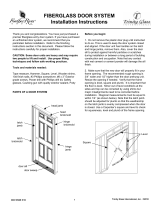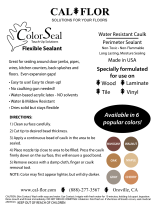
DOC1INSF 10/18 | © 2018 Trinity Glass International, Inc.
- 7 -
IMPORTANT: Reinstall weatherstrip. Remove excess shims.
Do not shim or screw through the head jamb of the single door unit.
For in-swing doors, install a corner seal pad (included in the installation kit)
at each bottom corner of a hinge or latch jamb per Figure 6a. For a double
door system, verify that a corner seal pad is installed at the bottom of the
astragal. The corner seal pad should be tucked underneath the weatherstrip.
Caulk at the intersection of the jambs, mullion base, brickmoulds, threshold and
floor. For out-swing doors, also caulk at the intersection of the jambs, mullion base,
brickmoulds, threshold and floor per Figure 6b.
FINAL INSTALLATION NOTES:
DEADBOLT STRIKE: Place shims both above and below the deadbolt strike
(not included). Be careful not to bow the jamb. Use long screws through the
deadbolt strike to anchor the strike into the frame opening. If the strike prep
must be larger, use standard woodworking tools on both wood and PVC jambs.
PLASTIC DOOR PLUG: Remove the plastic door plug completely.
DOOR LITE PLUGS: Every door with a lite comes with enough plugs to fill all screw holes. All screw plugs should have a tight
fit when installing to keep them from falling out. To install a screw plug, line it up with a hole. Align contours on the screw plug
with the lite frame contour. Start at a slight angle. In some cases you may be able to push the plug into place with your hand.
In most cases, you will need to use a tool to lightly tap the plug into place. If it seems that the screw plugs are too tight, slightly
sanding or filing the edge of the bottom side of the plug will allow the plug to fit easier.
INTERIOR TRIM INSTALLATION: Use a standard finishing nail (2d, 1", 16 gauge) to install interior trim. Drill a 1/16" pilot hole to
guide direction of finish nail.
BRICKMOULD KIT APPLICATION: Apply wood or PVC Composite Brickmould in a similar fashion. Put a 1/2" bead of sealant on
backside of Brickmould. Use an exterior grade finish nail (6d, 2", 13 gauge). Drill a 1/16" pilot hole to guide direction of finish
nail. Cover nail holes using provided putty stick or wood putty depending on finish of trim.
STORM DOOR INSTALLATION: Drill pilot holes for any fasteners used to install a storm door.
FINISHING INSTRUCTIONS:
Staining or painting an unfinished Feather River fiberglass door has never been easier. Our fiberglass
door does not require special stain kits or primer. Use the same exterior stain or paint you would use
for finishing your home’s other trims. When finishing, remove the door from the frame and place door
in a flat level surface off the floor. Do not remove sidelites from the door frame for finishing. Leave
sidelites in their original installed position.
CAUTION: PAINT OR STAIN IN A WELL VENTILATED AREA. KEEP COMBUSTIBLE PAINT, STAIN
AND TOPCOAT AWAY FROM HEAT AND FLAME. KEEP OUT OF REACH OF CHILDREN.
STAIN FINISH:
All surfaces of a tan woodgrain door are stainable. Our patented textured fiberglass door surface
yields superior stain adhesion without sanding. Select a high quality water-based stain, or a high
quality gel stain. Or, select a high quality oil-based stain. Before applying a stain, wipe the fiberglass
door and door lite frame with a damp cloth to remove any dirt, oil, or debris. Allow the surface to fully
dry before staining. Apply an even amount of stain with a brush or lint-free cloth in the direction of the
wood grain as shown in Figure 6. Work the stain into the surface. Lighten stain and remove excess
through wiping with a clean rag before stain dries completely. For a darker appearance, apply a second
coat after first coat dries. Follow the application instructions on the stain container label. After stain has
dried for at least 24 hours, apply three coats of high quality exterior grade satin or low gloss polyurethane
in the direction of the wood grain. Follow the label’s drying time between coats.
IMPORTANT: Use polyurethane with ultraviolet (UV) inhibitors.
6
Figure 6
Figure 6a
(inswing)
Figure 6b
(outswing)
Corner seal pad
Caulk
Caulk
Weatherstrip












